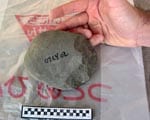
Science journalist Ker Than writes on the April 8 Daily News blog of National Geographic about the first-ever scientific expedition into a volcanic magma chamber, citing analysis from SMU volcanologist James E. Quick, a professor in the Huffington Department of Earth Sciences.
The expedition into Iceland’s dormant Thrihnukagigur volcano in October charts a chamber shaped like a long-necked bottle, with the neck rising up to the surface of the earth and the massive chamber down below.
“Magma chambers supply the molten rock that oozes or bursts onto the Earth’s surface during an eruption,” wrote Than. “The bottom half is about a hundred feet (30 meters) across, while the ‘neck’ that connects to the surface is only about 10 feet (3 meters) wide. The entire chamber is about 450 feet (137 meters), from top to bottom.”
For the story — “Volcano Pictures: First Descent Into a Magma Chamber” — Than interviewed Quick, associate vice president for research, and dean of graduate studies.
Quick, who was not part of the expedition, said the magma channels the team discovered appear to be “beautiful textbook examples of how magma can be transported laterally in the Earth’s surface and stored in shallow chambers.”
Quick’s analysis about the magnitude of the expedition is excerpted below.
EXCERPT:
James Quick, a volcanologist at Southern Methodist University in Dallas, Texas, said the Thrihnukagigur expedition will provide a firsthand look into a part of Earth only roughly known before.
“We knew from geophysical tools what the plumbing system inside of a volcano looked like, but we only knew it in the crudest way,” said Quick, who wasn’t part of the expedition.
While inside the Thrihnukagigur magma chamber, about a hundred miles (160 kilometers) away, the expedition team’s biggest risk was gas poisoning, SMU’s Quick said.
“Whenever you go into magmatic systems like that, you run the risk of exposure to high levels of carbon dioxide” that can well up from Earth’s interior, he said.
The University of Rhode Island’s Sigurdsson — who was prepared for such a scenario — said the thought did occur to him during his descent.
“I sniffed the air as I went down to see if I felt light-headed at all,” he said. “I had a
[gas mask] in my backpack, but we didn’t need it.”
Read the full story.
SMU is a nationally ranked private university in Dallas founded 100 years ago. Today, SMU enrolls nearly 11,000 students who benefit from the academic opportunities and international reach of seven degree-granting schools. For more information see www.smuresearch.com.
SMU has an uplink facility located on campus for live TV, radio, or online interviews. To speak with an SMU expert or book an SMU guest in the studio, call SMU News & Communications at 214-768-7650.



 Ancient tree-ring records from southwest U.S. suggest today’s megafires are truly unusual
Ancient tree-ring records from southwest U.S. suggest today’s megafires are truly unusual